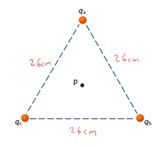
College Physics
11th Edition
ISBN: 9781305952300
Author: Raymond A. Serway, Chris Vuille
Publisher: Cengage Learning
expand_more
expand_more
format_list_bulleted
Concept explainers
Question
thumb_up100%
Point charges qa, qb, and qc are located at the corners of an equilateral triangle, 26cm on a side. Charge qa = 1.8nC is located at the top, charge qb = -7.9nC is located at the right and charge qc = 1.9nC is located at the left.
Find the magnitude of the electric field in newtons per coulomb at the center of the triangular configuration of charges.
Find the direction of the electric field in degrees below the right-pointing horizontal (positive x-axis)

Transcribed Image Text:2 всту
в
гост
.
і 26смі
і
1
Expert Solution
This question has been solved!
Explore an expertly crafted, step-by-step solution for a thorough understanding of key concepts.
This is a popular solution
Trending nowThis is a popular solution!
Step by stepSolved in 5 steps with 5 images

Knowledge Booster
Learn more about
Need a deep-dive on the concept behind this application? Look no further. Learn more about this topic, physics and related others by exploring similar questions and additional content below.Similar questions
- Problem 8: The electric force experienced by a -4.8 μC charge at some point P has a magnitude of 18 N and points due North. Part (a) What is the magnitude of the electric field, in newtons per coulomb, at P? Part (b) What is the direction of the electric field at point P? Part (c) What is the magnitude of the force, in newtons, that an electron would experience if it were placed at point P instead of the given charged particle? Part (d) If a proton were placed at point P instead of the electron, what is the magnitude of the force, in newtons, that it would experience? Part (e) What is the ratio of the magnitude of the acceleration of an electron to that of a proton, when the electric field acting on each has the same strength?arrow_forwardThe drawing shows two situations in which charges are placed on the x and y axes. They are all located at the same distance of 5.00 cm from the origin O. For each of the situations in the drawing, determine the magnitude of the net electric field at the origin. -l.0 μC +1.0 uC +2.0 uC -3.0 µC +4.0 µC -1.0 uC o! +6.0 uC (b) (a)arrow_forwardFour point charges, q1 = 8.2 uC, q2 = -7.8 uC, q3 = 1.7 uC and q4 = -5.9 uC, are arranged in a square with side lengths L = 7.5 cm. What is the magnitude of the electric field at the centre of the square?arrow_forward
- Two point charges are lying on the y- axis as in the figure: q₁ = -4.10 μC and 92 = +4.10 µC. They are equidistant from the point P, which lies on the x- axis. (a) What is the magnitude of net electric field at P? (b) A small object of charge qo = 7.30 µC and mass m = 1.24 g is placed at P. When it is released, what is the magnitude of its acceleration? 91 92 + (a) Number (b) Number 0.880m 31.5 31.5° 0.880 m +x Units Units !!arrow_forwardA uniformly charged spherical shell has inner and outer radii of 24.0 cm and 32.0 cm, respectively. A point charge of −45.0 nC is located at the center of the spherical shell. A proton orbits around this arrangement just outside the spherical shell with a speed of 8.32 ✕ 105 m/s. What is the volume charge density of the spherical shell? (Include the sign of the value.)arrow_forwardThree charges are on the plane (x,y) as reported on the picture. The two charges q on the x-axis are equal and at distance of 8 cm from the origin. The charge on the y-axis is negative and 3q and it is at 16 cm from the origin. Determine the x component of the electric field at the point P (0,5) cm. q P -39 qarrow_forward
arrow_back_ios
arrow_forward_ios
Recommended textbooks for you
 College PhysicsPhysicsISBN:9781305952300Author:Raymond A. Serway, Chris VuillePublisher:Cengage Learning
College PhysicsPhysicsISBN:9781305952300Author:Raymond A. Serway, Chris VuillePublisher:Cengage Learning University Physics (14th Edition)PhysicsISBN:9780133969290Author:Hugh D. Young, Roger A. FreedmanPublisher:PEARSON
University Physics (14th Edition)PhysicsISBN:9780133969290Author:Hugh D. Young, Roger A. FreedmanPublisher:PEARSON Introduction To Quantum MechanicsPhysicsISBN:9781107189638Author:Griffiths, David J., Schroeter, Darrell F.Publisher:Cambridge University Press
Introduction To Quantum MechanicsPhysicsISBN:9781107189638Author:Griffiths, David J., Schroeter, Darrell F.Publisher:Cambridge University Press Physics for Scientists and EngineersPhysicsISBN:9781337553278Author:Raymond A. Serway, John W. JewettPublisher:Cengage Learning
Physics for Scientists and EngineersPhysicsISBN:9781337553278Author:Raymond A. Serway, John W. JewettPublisher:Cengage Learning Lecture- Tutorials for Introductory AstronomyPhysicsISBN:9780321820464Author:Edward E. Prather, Tim P. Slater, Jeff P. Adams, Gina BrissendenPublisher:Addison-Wesley
Lecture- Tutorials for Introductory AstronomyPhysicsISBN:9780321820464Author:Edward E. Prather, Tim P. Slater, Jeff P. Adams, Gina BrissendenPublisher:Addison-Wesley College Physics: A Strategic Approach (4th Editio...PhysicsISBN:9780134609034Author:Randall D. Knight (Professor Emeritus), Brian Jones, Stuart FieldPublisher:PEARSON
College Physics: A Strategic Approach (4th Editio...PhysicsISBN:9780134609034Author:Randall D. Knight (Professor Emeritus), Brian Jones, Stuart FieldPublisher:PEARSON

College Physics
Physics
ISBN:9781305952300
Author:Raymond A. Serway, Chris Vuille
Publisher:Cengage Learning

University Physics (14th Edition)
Physics
ISBN:9780133969290
Author:Hugh D. Young, Roger A. Freedman
Publisher:PEARSON

Introduction To Quantum Mechanics
Physics
ISBN:9781107189638
Author:Griffiths, David J., Schroeter, Darrell F.
Publisher:Cambridge University Press

Physics for Scientists and Engineers
Physics
ISBN:9781337553278
Author:Raymond A. Serway, John W. Jewett
Publisher:Cengage Learning

Lecture- Tutorials for Introductory Astronomy
Physics
ISBN:9780321820464
Author:Edward E. Prather, Tim P. Slater, Jeff P. Adams, Gina Brissenden
Publisher:Addison-Wesley

College Physics: A Strategic Approach (4th Editio...
Physics
ISBN:9780134609034
Author:Randall D. Knight (Professor Emeritus), Brian Jones, Stuart Field
Publisher:PEARSON